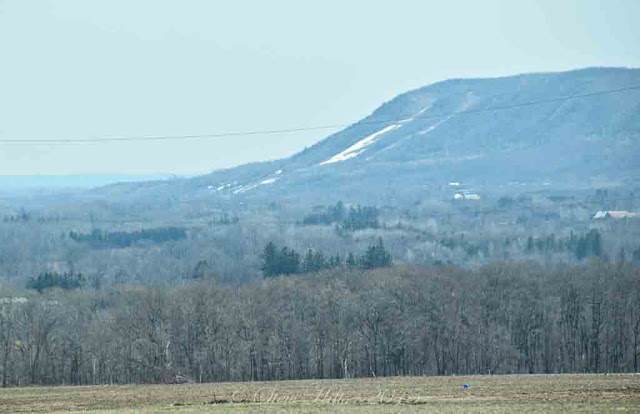We always used to laugh at the couples out for a Sunday afternoon drive, just moseying about the countryside, slowing down traffic. Now we're one of them and on a warm sunny day like last Sunday, it was wonderful! We went in search of cranes, frogs calling, and Skunk Cabbage. We found two of the three.
The first thing we stopped for was a pair of very blue Tree Swallows who have obviously claimed this nesting box. Driving by you can easily mistake the flash of blue for Eastern Bluebirds.And off in the distance to the east there was still snow on some of the runs at Georgian Peaks, the north-westerly most ski club on Blue Mountain.
We ended up stopping and taking a good look at the large Red Price apple orchard just west of Clarksburg, noticing especially the large bulge at the rootstock grafts near the ground. It makes quite a pattern looking through this very high density orchard.
So I got online today and started researching apple rootstocks and grafting. It's a fair bit more complicated than I realized. Apples are generally not grown from seed, because they won't be 'true-to-type'. So to get an orchard of Red Prince you need to choose a rootstock and graft a 'scion' or healthy Red Prince twig onto the rootstock of every tree. The scion determines the apple type.
The rootstock determines the relative size of the tree, from dwarf to standard. They need to be held up by trellising, especially once they are laden down with fruit. The bulge is the location of the graft. I've looked to find out why the bulges here are so prominent, but the only thing I can come up with is that there are still several types of rootstock among dwarf trees bred for resistance to cold, fire blight, insects and disease, and woolly apple aphid.
Most breeding and research comes from universities or agricultural research stations like Cornell in New York, or Malling in England.. In our case the Vineland Research Station of the Ontario Ministry of Agriculture and Food is important. Dwarf trees do tend to fruit earlier, after only 2 or 3 years, but research has not determined exactly why this is.
We carried on down to the Epping Road through the Beaver Valley swamp, a place where we hoped we'd hear frogs calling. We didn't, but the reflections among the Silver Maples were good for a picture.









Pussy Willow , when we lived at Lake Tarawera, there were many trees alongside the narrow winding road into Rotorua, and each spring, they showed those lovely catkins .How good that your weather is definitely showing promises of warmer days.
ReplyDeleteIt is so nice to get out and see spring starting finally although it sure doesn't feel like spring today.
ReplyDeleteLove those drives through the countryside, Sunday or otherwise. The Tree Swallows are back here as well. Interesting info about the apple trees, FG.
ReplyDeleteNice Sunday afternoon drive.
ReplyDeleteWhen I was a kid we did that often and would stop and have ice cream somewhere.
What a nice Sunday afternoon drive.
ReplyDeleteAll the best Jan
What a wonderful drive. We had barn swallows when I was a kid, but I haven't seen any here in the city. My favorite photo were the pussy willows. A wonderful sign of spring.
ReplyDeleteLove the second picture of the gnarly apple tree orchard! BTW, if you are wanting to hear the frogs - you are welcome any late afternoon to the Ridge. ;) Bill would e happy to send some home with you. Ha ha
ReplyDeleteLove the Pussy Willows, and seeing the different way of raising apples. Our trees may have grafts also, but I haven't yet seen those miniature varieties around here. Within about 30 miles are lots of apple orchards. I'll have to go see them sometime!
ReplyDeleteNothing wrong with a drive on a pleasant day. I went to college with a fellow who was a plant geneticist, he word weekends grafting apples for a number of large apple orchards -- it's a skill that takes time to develop.
ReplyDeleteFor an old fogey you had a very enjoyable afternoon drive.
ReplyDeleteWe used to live in the country next to a swamp and we always looked forward to hearing the Spring Peepers. I didn't realize that most apple trees are grafted. Next time we're in the Okanagan I'll look for those lumps.
ReplyDeleteIt always surprises me to see how small orchard tress are kept.
ReplyDeleteI am a proud member of the group that meanders slowly through the countryside, taking everything in, honking horns be damned.
ReplyDeleteNext time I have an apple in my hand I'm going to ask it about its lineage.
ReplyDeleteThis comment has been removed by the author.
ReplyDeleteOur pussy willows are done! I love a Sunday drive, but we do them during the week. Too many crazy people, too many motorcycles, too!
ReplyDeleteA very long time ago when I was in College one class I took was on woody plants and we did some grafting. If I recall correctly a bulge can be formed when the tree is wrapped above and below the graft. I gave my parents a couple of trees that I grafted and we planted some at the place we lived at the time...not sure any of them grew. I should stop by my parents old place and see if any of the trees are still alive. That is one pretty Apple Orchard!
ReplyDelete